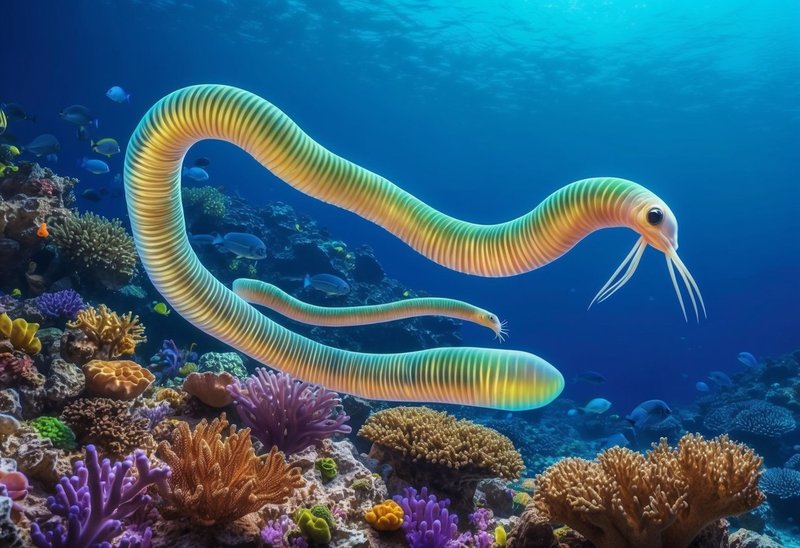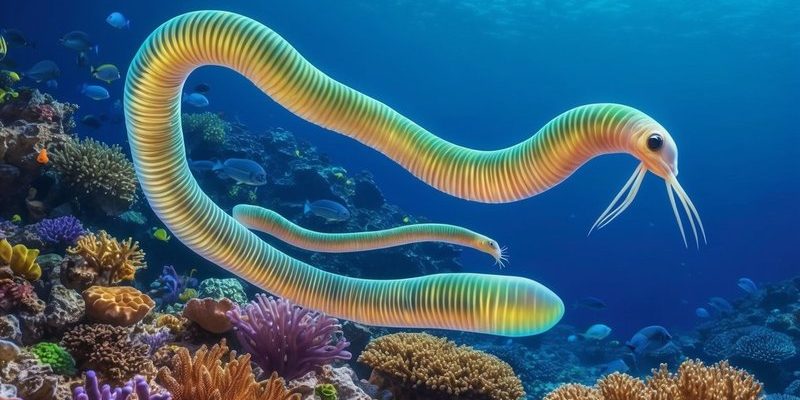
Exploring the complex relationships within coral reef ecosystems can feel a bit like piecing together a jigsaw puzzle. Each creature, from the tiniest fish to the largest sharks, plays a part in maintaining the balance of life. Bobbit worms, while not as well-known as some of their reef neighbors, contribute to this balance. But how do they fit in? Let’s dive deeper into the underwater world of the Bobbit worm and see just how it interacts with other reef predators.
Understanding Bobbit Worms
To get a clear picture of how Bobbit worms operate in their environment, it’s essential to understand what they are. These worms can grow up to 10 feet long and are generally found in warm, shallow waters. Their bodies are segmented and covered in bristles, which help them navigate their surroundings.
What’s fascinating is their aggressive hunting style. Bobbit worms stay hidden in their burrows, waiting patiently for unsuspecting prey to swim by. Using their powerful jaws, they can snatch up fish and other small animals, much like a trap door spider. This method of ambush allows them to thrive in their niche, but it also puts them in direct competition with other predators in the reef.
Imagine being at a busy restaurant where several chefs are trying to prepare the most delicious dishes. Each chef has their style, but they all want the same ingredients. That’s pretty much how Bobbit worms interact with other reef predators—they’re all vying for the same food sources, which can lead to intense competition.
Bobbit Worms vs. Other Reef Predators
Bobbit worms share their environment with a variety of other predators, such as *moray eels*, *lionfish*, and even *octopuses*. Each of these creatures has developed unique hunting strategies that help them survive. For instance, moray eels are known for their stealth, while lionfish rely on their venomous spines to ward off threats.
The competition among these predators can be fierce. If you picture a bustling marketplace, with various vendors trying to sell their goods, you can get a sense of how these marine animals coexist. Sometimes there are turf wars; other times, they might strike a truce for a common benefit, like abundant prey.
The Bobbit worm, with its quick strikes and impressive camouflaging abilities, can hold its own. While it may not be the fastest swimmer, its ability to stay hidden and then launch a sudden attack can often give it the upper hand against faster competitors. However, when food is scarce, these predators may clash more frequently, leading to an interesting dynamic beneath the waves.
The Role of Competition in Coral Reefs
Competition among predators like Bobbit worms contributes to the health of coral reef ecosystems. When multiple species vie for the same resources, it helps keep the populations in check. This balance is crucial, as an overabundance of any one species can lead to negative effects on the entire ecosystem.
For example, if Bobbit worms were to overwhelm the fish population, it could lead to a decline in the health of the reef due to the loss of vital species that contribute to its structure and function. Conversely, if the Bobbit worm population is kept in check by its competitors, it can lead to a healthier overall environment.
Moreover, this competition drives evolution. Animals that can adapt their hunting tactics or develop new skills may thrive, leading to a more diverse and resilient reef ecosystem. Picture it as a dance, where each player adapts to the rhythm of the other, creating a beautiful and dynamic performance.
Food Sources and Feeding Behavior
The types of prey that Bobbit worms hunt can vary, and this influences their interactions with other reef predators. They primarily feed on small fish, crustaceans, and invertebrates. Their method of feeding is fascinating, as they rely on both speed and stealth to catch their meals.
When a fish gets too close, the worm can strike with an incredible speed, sometimes catching prey before it even knows what’s happening. This feeding behavior positions Bobbit worms as formidable opponents; however, they also face threats from other predators.
For instance, while Bobbit worms are busy hunting, moray eels might also be on the prowl, searching for the same food sources. This hunt creates a competition dynamic where both species must adapt and innovate in their hunting strategies. Think of it like playing chess, where every move counts, and anticipating your opponent’s next step is key to survival.
How Habitat Affects Competition
The coral reef itself plays a significant role in shaping the dynamics among predators such as Bobbit worms. The structure of the reef, the availability of hiding spots, and the abundance of prey can all influence how these creatures interact.
In areas with dense coral formations, Bobbit worms may find more places to conceal themselves, giving them an advantage over predators that rely on open water. On the other hand, in more barren or damaged reefs, competition can be harsher due to limited hiding spots and food sources. Picture a crowded city versus a rural town; the city has resources but also more competition, while the rural area may have less competition but also fewer options.
When coral reefs are healthy, the abundance of resources can allow various species to thrive together. However, as climate change and pollution threaten these habitats, the competition among Bobbit worms and other predators can become more intense. Protecting these ecosystems becomes crucial to maintaining the balance of competition and survival.
Conservation and Future Outlook
Given the vital role of Bobbit worms and other reef predators in their ecosystems, conservation efforts are essential. Healthy coral reefs support a vast array of marine life and protect coastal communities. When we think about protecting our oceans, we’re not just safeguarding Bobbit worms; we’re preserving a whole web of life.
Efforts to combat climate change, reduce pollution, and restore damaged reefs can benefit all species, including the enigmatic Bobbit worm. A thriving reef helps maintain a balance among predators, ensuring that competition remains healthy rather than destructive.
Ultimately, the future of Bobbit worms and their competitors rests on our ability to care for the marine environments they inhabit. By supporting sustainable practices and advocating for cleaner oceans, we can help secure a vibrant future for these incredible creatures and the ecosystems they enrich.
Bobbit worms may not be the most glamorous residents of coral reefs, but they play a vital role in their ecosystems. They compete with other predators and contribute to the balance of life beneath the waves. Understanding their relationships with other reef inhabitants gives us insight into the complex dynamics at play in these vibrant ecosystems.
As we continue to learn about the underwater world, it’s crucial to remember that every creature, from the smallest Bobbit worm to the grandest shark, has its part to play. By appreciating these connections, we can better advocate for the health of our oceans. After all, a balanced reef benefits all marine life and the human communities that depend on them.

